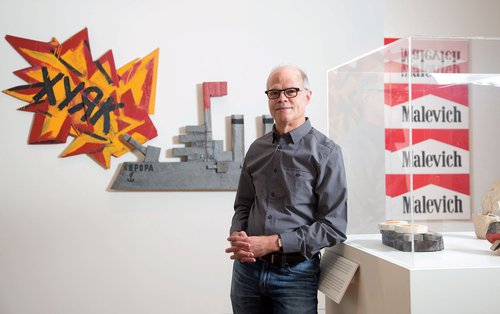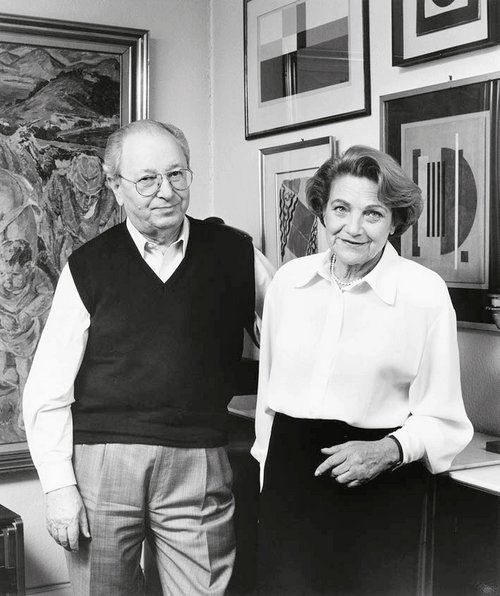Nemukhin’s Solitaire of Postmodernism

Vladimir Nemukhin. Abstraction Games. Exhibition view. Moscow, 2025. Courtesy of State Tretyakov Gallery
An exhibition marking the centenary of nonconformist artist Vladimir Nemukhin has opened at the State Tretyakov Gallery in Moscow.
Vladimir Nemukhin (1925–2016) belonged to the generation of artists of Moscow's unofficial art scene, the underground. They were artists who emerged during the Thaw era having come together in the late 1950s in the Lianozovo Group. Poets Genrikh Sapgir (1928–1999), Igor Kholin (1920–1999), Vsevolod Nekrasov (1934–2009), Yan Satunovsky (1913–1982), artist-poets Yevgeny Kropivnitsky (1893–1979) and Lev Kropivnitsky (1922–1994), artists Valentina Kropivnitskaya (1924–2008), Oskar Rabin (1928–2018), Nikolai Vechtomov (1923–2007), Lidiya Masterkova (1927–2008), and Vladimir Nemukhin gathered together from the late 1950s to the mid-1970s on the outskirts of Moscow, in the depressed district of barracks and abandoned buildings at Sevvodstroy, near the Lianozovo railway station. These young artists were inspired by new knowledge about the avant-garde in connection with the 1957 World Festival of Youth and Students and the 1959 American National Exhibition in Sokolniki. This world of new art which was suddenly revealed to them became a powerful stimulus to create in ways completely different from what was accepted within the strict boundaries of official Soviet cultural policy. Stuffy Socialist Realism was forgotten and erased. Abstract Expressionism, Minimalism, and the Trans-avantgarde became guiding stars for these young artists.
Like other Lianozovo members, Vladimir Nemukhin plunged into this maelstrom of diverse formal explorations. In essence, the Lianozovo Group had no programme and no unified system or style. According to Nemukhin’s own accurate judgement, it was held together by the mutual attraction of people seeking freedom. This was precisely a fellowship of artists. Interestingly, the current Nemukhin show at the Tretyakov gallery in Moscow, supported by the AZ Museum, begins with a display of works from the artist’s own collection which he donated to the Tretyakov. This collection, like Noah's Ark, consists of one or several works by each artist who belonged to the Lianozovo association. Nemukhin's first wife Lidiya Masterkova, Olga Potapova (1892–1971), Lev Kropivnitsky, and Nikolai Vechtomov each interpreted abstraction in their own way. Sometimes at the intersection with figuration, sometimes in the pure radiance of streams of light and colour.
Comparing Soviet unofficial artists with American Abstract Expressionists such as Jackson Pollock (1912–1956) and Mark Rothko (1903–1970) is ultimately misguided. In the Soviet case, we are dealing with a distinctly vernacular interpretation of style, rooted in lived experience and an intuitive grasp of process, where naive conjectures and fragmentary memories of the first Russian avant-garde become the key motifs in a new kind of montage.
According to Vladimir Nemukhin’s memoirs, included in a book which the AZ Museum has published for the exhibition, abstraction possessed his mind and heart until the mid-1960s. Then came an understanding of the search for a more complex assemblage of style. The artist writes that carnal, sensual, unbridled Expressionism had tired him. He desired a constructive, conceptual assembly of time and space. Playing cards helped Nemukhin with this.
The theme of playing cards is enticing for artists. Card suits simultaneously liberate the imagination and introduce the element of play. At the same time, they are assembled very constructively. Rhythm, colour, predetermined principles of composition, and the structure of the images on the reverse hold our eyes in strict discipline. This dual intrigue has attracted artists for centuries. Mediaeval artists exercised ingenious wit in presenting cards as a kind of mystical behind-the-looking-glass of everyday life. Baroque artists readily introduced cards into vanitas still lifes – vanity of vanities. They painted gamblers. In their paintings, cardboard sheets with red and black numbers and little portraits set the frame to an intriguing visual drama, an almost choreographic étude.
In different epochs, images of kings, queens, jacks, jokers, and the ornamentation of ace suits presented the quintessence of one style or another in laconic, vivid embodiment. Rococo, Classicism, Eclecticism, Symbolism – card figures excellently convey the fashion and spirit of the times.
The avant-garde chose card games as a portal to the world of the irrational, simultaneously connected with lowbrow, vulgar culture, the entertainments of commoners and criminals. Thus, the society of Russia's first avant-garde artists at the beginning of the twentieth century chose the name ‘Jack of Diamonds’ (Bubnovy Valet). Cards became an indispensable attribute of Cubo-Futurist still lifes, in which analysis and dissection of form combine with a taste for what traditionally lies on the periphery of our attention.
Vladimir Nemukhin gathered much from the artificialized history of playing cards. He created his own philosophy and intrigue. Above all, he categorically separated himself from the idea of everyday symbolism, alchemy, and mysticism. He set himself the task of declaring the playing card as an object and bringing it into the realm of pure plasticity. The paintings with cards assembled at the exhibition show us an analytical process of investigating the surface of the image. Lined cardboard pieces thrown onto a card table stratify the surface, giving an interesting experience of depth and plane. In my view Erik Bulatov (1933–2025) did something similar by introducing words into landscapes: the same active experience of the depth of illusory space and surface as the borderland of different spatial zones.
Playing cards helped Nemukhin resolve the problem of his self-imposed authorial taboo on portraits. The artist began constructing the ‘faces’ of card figures. In the exhibition, one can encounter an entire gallery of ‘jacks’. Some are named after famous figures of the Russian avant-garde: for example, Jack Malevich, Jack Meyerhold. By inscribing the image into a card costume, Nemukhin sublimates various qualities, one might say, memes of avant-garde aesthetics. Thus, theatre director Vsevolod Meyerhold (1874–1940) appears in the image of a commedia dell’arte character, but dressed as heroes of the Constructivist theatre. Kazimir Malevich (1879–1935) is composed of Suprematist modules: crosses, triangles, diagonals. The non-objective man is inscribed in the landscape of the ‘peasant cycle’.
The card game allows one to experience art history in the spirit of an exciting poker game, shuffling decks, composing combinations. In my view, the exhibition helps one reflect on the nature of Russian postmodernism. Quotation, pastiche, the combinatorics of words and concepts without pretensions to a fateful pronouncement bring the poetics of postmodernism closer to the image of a card game. Vladimir Nemukhin never considered himself a postmodernist. However, today, with new experience of historical perspective, many themes of unofficial art have become friendly to postmodernist strategies. Hidden quotations in Nemukhin's card paintings, his reinterpretation of Cubo-Futurist still lifes and Constructivism, introduce a light situation of exchanging witty remarks and offer the pleasure of trading jokes in the course of an intellectual conversation amongst erudites.
Vladimir Nemukhin. Abstraction Games
Moscow, Russia
11 November, 2025 – 9 March, 2026

























